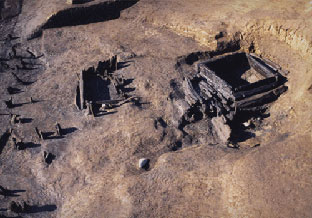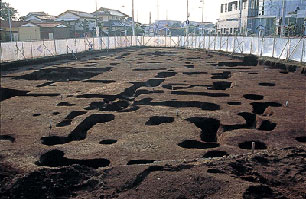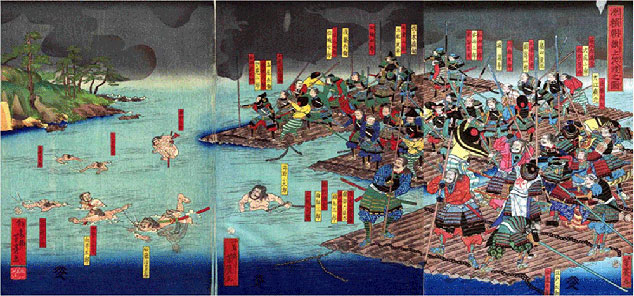公開日 2021年11月12日
Heian Period
Village Life
Emperor Kanmu moved the capital of Japan to Kyoto in 794 and named it Heian-kyo, which means the Capital of Peace.Here started the Heian period in which the culture of the nobles developed.
Just like the dwelling sites of the Nara period, together with pit dwellings, buildings with pillars inserted directly into the ground were excavated from the Heian-period dwelling sites in Isehara. Remains of more than a hundred dwellings were unearthed at the sites of Higashi-Otake’s Ichiba, Numame’s Tennobara, and Tsubonouchi’s Enoto, telling us that a large number of people continued to live in the same places. Among the excavated artifacts are reddish-brown hajiki and grey-colored sueki pottery carried from the Tokai district and other parts of the Kanto district. This shows that people traded actively, as before, with those who lived in quite a distance away. It seems that officers were dispatched here by the central government because high-quality goods such as glazed ceramics produced in present Aichi and Gifu Prefectures and belt buckles showing the ranks were also discovered in the sites.
At the Ichiba site in Higashi-Otake, together with the remains of more than ten storehouses, the keys to the storehouses, copper coins minted in 870 (twelfth year of the Jogan era), and earthenware with ink letters on it were unearthed. In the Sakabayashi site, Tanaka, the remains of a smithy which produced iron tools were discovered. Although the dwellings increased in number and villages grew larger in size in the early Heian period, the population and the villages gradually became smaller in Isehara in the late Heian period.

- The remains of a well were discovered in the Naruse Second-District site.

- Holes where the pillars were inserted were found in the four corners of the storehouses with raised floors in the Higashi-Otake’s Ichiba site.
Warriors in Power
All areas of Japan seemed under the rule of the central government in Kyoto, but its control became less strict past the mid-Heian period.
The nobles, as well as the temples and shrines, expanded their privately-owned manors, toppling the land system which supported the finance of the central government based on the laws. The imperial court lost its influence in governing the areas away from Kyoto, while the armed local clans came to gain the power. In order to confront these powerful provincial clans, the imperial court had to ask warriors for their support, which accelerated forming military clans.
Taira no Kiyomori established the military government, marrying his daughter to the emperor. This, however, made their rival, the Genji clan, who was strengthening its power in eastern Japan, stand up. Both military clans fought against each other, and the battles became more and more fierce moving the front farther to the west. In 1185, the Heike clan was destroyed completely at Danno-ura, in present Yamaguchi Prefecture.
The leader of the Genji clan Minamoto no Yoritomo was appointed shogun and established the shogunate government in Kamakura in 1192. For the following 670 and some years, the military class assumed control of Japan till the Meiji Restoration, when the emperor restored his power.

- This woodblock print, made in the Edo period, depicts the scene in which Yoritomo was getting away to the Boso Peninsula after he lost the battle in Ishibashiyama, Odawara.
- Okazaki Shiro Yoshizane, who was related to Isehara, can be seen in the rear.
Next⇒Kamakura Period
- Geogaraphical Features of Isehara
- Paleolithic Period
- Jomon Period
- Yayoi Period
- Kofun (Tumulus)Period
- Nara Period
- Heian Period
- Kamakura Period
- Muromachi Period
- Civil War Period
- Edo Period
- Meiji, Taisho, and Showa Periods
Previous⇒Nara Period


